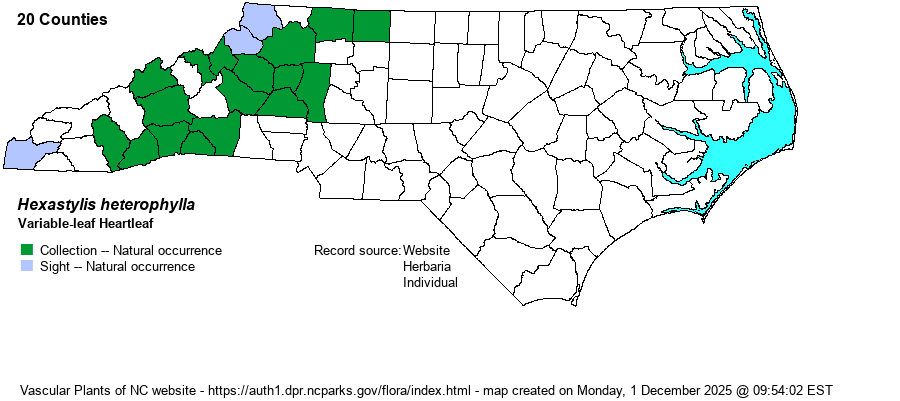| Identification | More than other montane Hexastylis species, this one tends to have leaves that are not varietated in white or light green along the veins. However, it is not named as Variable-leaf Heartleaf for no reason; some or many leaves can have pale veining on the top surface, but it usually is not as strongly white-veined as H. shuttleworthii or H. minor. It has similar leaves to those, with a few heart-shaped leaves about 3 inches across and wide, being dark green, shiny, thick, and evergreen. Thus, as for about all species in the genus, you must look at the flowers to be certain. This species has several purple-brown flowers -- thick and fleshy calyx tube with no petals -- growing at ground level, often under fallen leaves. The tube is cylindrical, with three quite large, triangular calyx lobes. In this species, the opening to the tube is about 10 mm (2/5-inch) wide, roughly half the length of a calyx lobe. Hexastylis minor is similar, but its calyx tube is a bit wider near the opening, and this opening is wider than the length of a calyx lobe; and, it always has very strongly white-veined leaves. The rare Hexastylis naniflora has a quite small opening (orifice) to the calyx tube, only about 1/4-inch wide, and the calyx lobes are very short as well. Hexastylis shuttleworthii flowers are quite large but are urn-shaped (curved toward the orifice) as opposed to straight-sided; its leaves are almost always strongly white-veined. Hexastylis virginica has flowers with very short calyx lobes (only 2-4 mm long) and they are erect or barely flaring, as opposed to widely flaring (sideways) in H. heterophylla. This species is usually not too difficult to find in the northern half of the foothills, and usually they are first noticed by non-variegated or poorly variegated leaves, but final identification needs to be made with flowers, not with leaf color. | |

